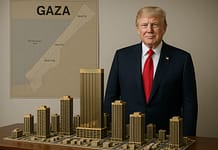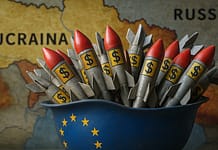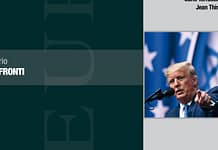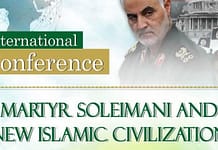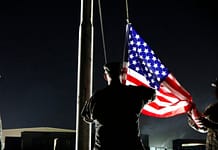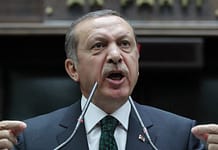The current paper has been presented at the Second Conference on the Decline of the United States. It is based on some analysis that have been published by the author in “Eurasia. Rivista di studi geopolitici” (an Italian quarterly magazine of geopolitical studies).
The main question posed from the chaotic withdraw of the western coalition led by United States in Afghanistan is the following: is the global hegemony of United States really ending or we are witnessing only a strategic withdraw form Central Asia in order to focus on other areas, such as the Indo-Pacific region?
Western medias have covered the withdraw from Afghanistan underlying only some aspects and emphasizing the presumed failure of the operation. The author of the paper will try to provide a different interpretation of the recent events. The “Operation Afghanistan”, from a strategical point of view and despite the end of a formal US presence in Central Asia, has not been a disaster for Washington and the Pentagon. As President Joseph R. Biden clearly stated in the days of the withdraw, the target of the United States in Afghanistan was not the Nation-building. The real target was stopping (or delaying) the construction of an anti-hegemonic bloc in Eurasia creating chaos. Therefore, despite the macroscopic troubles of the western thalassocratic superpower (especially on the internal level) and the signs of its decline, the author believes that is still early to talk about the end of the American global hegemony. History taught us that even after the withdraw from Saigon (after a war that United States really fought, not like in Afghanistan) Washington was anyway able to become the only global superpower in less than twenty years. In fact, in both Vietnam and Afghanistan, the US target was not to win the war but to avoid peace as long as possible.
The paper will be divided in three parts. The first part will provide some historical, ideological and geopolitical considerations about the decision of the United States to militarly engage the Talibans in Afghanistan.
The second part will focus on the inner characteristics of the Taliban movement. While the third part, the conclusions, will try to understand the future geopolitical dynamics in Central Asia after the withdraw of the West.
Some historical and ideological considerations
This year marks the twentieth anniversary of the tragic events of September 11, 2001. In this paper we will not analyze what exactly happened that day in New York and Washington DC, and we will not investigate or try to discover who is really guilty. This is not the main topic. Our purpose is to investigate and understand what happened before and after that event.
In 2001, United States were coming from a decade of absolute mastery on global level. Russia, still fighting in the Second Chechen War, was coming out from the disastrous Eltsin era. While China, even if economically growing, was still fighting with the ghost of the events of Tian’anmen square (one of the first western attempt to promote a “color revolution”).
Furthermore, in the decade from 1991 to 2001, the organic intellectuals to the American-lead global system were trying to provide an ideological superstructure able to read this new hegemonic era. The theories about the “end of history” and the shining future of the liberal-capitalistic paradigma that needed to be accepted in the whole world were born in this period.
Nowadays the same authors (such as Francis Fukuyama) that were prophesying the end of history are talking (probably making another mistake) about the end of American hegemony. This contingency, at least in the short time, seems still far and in this analysis we will try to demonstrate the reasons behind this idea.
Who used to talk about end of history was actually ignoring (more likely denying) the fact that American global hegemony was based (and it is still based) on a permanet state of war. War that is declined in all its forms: ideological war (propaganda); economic war (sanctions and embargos); military war (for instance, the aggressions to Afghanistan and Iraq). This hegemony, in fact, is built on three different dimensions.
First, a cultural dimension which consists of intepreting the geographical space with concepts absolutely compliant with the design of the American-lead system.
Second, an economic dimension which is based on the so called “food diplomacy”. Sanctions and embargos are the main tools of this dimension which has its historical reference in the “Anaconda Strategy” used by the General of the Union Winfield Scott during the American Civil War in the XIX centrury. Nowadays, the tragic effects of this kind of strategy are pretty clear in Syria, where the criminal Ceasar Act imposed by United States is making more victims than the war.
Third, a military dimension which entails the use of strenght where the American interests are directly threatened, or simply the sales of American made weapons to countries which are continously subjected to propaganda and ideological pressure about the risks posed by enemies that in reality are only American enemies (“enemies” that do not accept the American unipolar hegemony and supremacy).
The fact that this hegemony is founded on war (and the same very fact that war is an historical phenomenon not avoidable) makes every theory about an eventual “end of history” completely wrong since the beginning. For the entire past century, the American political-industrial-scientific complex has always showed a clear attitude towards war. However, after the collapse of Soviet Union, this complex found itself orphan of what it needed most: a real enemy.
The Report from the Iron Mountain: on the possibility and desiderability of peace is a doctrine elaborated in 1967 by some American politicians, scientists and scholars. This doctrine describes perfectly the above mentioned belligerent attitude of the American élites. For instance, it states: “the military system makes possible a stable control over society […] We need to insist on the necessity to find a qualitative convincing enemy. In our opinion, it is easier to create this threat rather than derive it from unknown conditions”[1].
These words sound pretty malicious if we consider the current situation of pandemic crisis. Especially if we consider the military rhetoric behind the measures to contain the spread of the virus used by the western political apparatus. De facto, it is quite common to hear expressions like “war on virus”, “hunting the virus”, “virus is the enemy” and so on. The vaccination campaign as well (possible in the West only with vaccines made by western based pharmaceutic multinational enterprises) in Italy (historically a laboratory for long term western geopolitical projects), is entrusted to the army linked with NATO.
These words sound even more malicious if we consider the historical reality of the last decade of the previous century, when the United States found themselves in the need of a new enemy able to justify their geopolitical action as “global police”. So, the already mentioned organic intellectuals started to develop “new” ideological theories about the so called “clash of civilizations” which were already refuting the position of the “end of history” supporters. These theories were well influenced by some sort of neocolonialist and racist perspectives: quite typical aspects of thalassocratic powers such as Great Britain and United States. Furthermore, these theories, together with the ridicoulos rethoric of democracy and human rights exportation, became the ideological frame for the new American interventionism in the world. An interventionism that, on the contrary, had mainly strategical targets.
The western aggressions to sovereign countries in the first two decades of the XXI century, from Afghanistan to Syria, must be understood especially with the American “need” to guarantee its hegemony in Eurasia and with the “need” to give breath to its military-industrial complex saturated by one decade of relative peace. Of course we do not want to underestimate the sinister charm exerted on the western oligarchies by the desire to exploit a great amount of natural resources. No one wants to deny the lucrative contracts signed by the western companies for the rebuilding of Afghanistan and Iraq (a well known practice applied in Europa with the so called Marshall Plan after 1945 to force European countries in the American geopolitical space). However, first of all, nothing has been rebuilt in both Afghanistan and Iraq. The two countries are still in a situation of deep chaos. Second, the interpretations of historical facts based only on the economic level (mainly produced by pseudo-marxist analysis of the reality wich deny military and geopolitical strategies) hide much more than what they really unfold.
When we try to analyze these events we can not avoid to consider the project “Greater Middle East” delivered by the Bush Jr. administration. This project has been thought and built on the same direction of the Zionist plan made by Oded Yinon during the eighties. The final target was to divide the Middle Eastern countries on sectarian and ethnic levels in order to foster the strategy of divide et impera.
As General Wesley Clark stated, the target of United States was to take out seven countries in five years[2]. Of course, the main target of this project was Iran. Iran had to be encircled from its western and eastern side taking positions in Afghanistan and Iraq. It is important to remember that CIA and Mossad started the operations against Iran already in the first years of the new century, particularly fostering terrorist infiltration in the region of Baluchistan. This region, located between Iran and Pakistan, in the plans of the Americans had to become an indipendent State. Even Saddam Hussein tried to support the cause of the armed groups of Baluchistan alternatively against Iran and Pakistan. An inquiry carried out by ABC news showed how CIA and Mossad supported with training and logistic the terrorist group named Jundallah[3]. The leader of this group Abdolmalek Rigi has been captured and executed by the Iranian security forces in 2010.
Nowadays, this group still operates on the Pakistani side of the border where it is allied with Tehrik-i-Taliban: the Pakistani Taliban group which, on the contrary with the Afghan Talibans, is allied with Daesh and, not surprisingly, is mainly a geopolitical tool for the West. In fact, its operations are focused on the sabotage of the CPEC – China Pakistan Economic Corridor. Now, let us focus on the Afghan case. In the moment that the western coalition threw down the first Taliban Emirate it was already pretty clear that there would not have been any Nation-building. The West named as president of the newborn Islamic Republic of Afghanistan Hamid Karzai: a man which comes from one of the largest Afghan criminal clan. At the same time, the new Afghan parliament became quickly a heap of warlords and druglords with different interests but with the common purpose to steal the money coming from international aid.
The main target of United States, in the Afghan case, was not the so called “war on terror” but to infiltrate their military power in a region of crucial strategic value. In the views of the American strategists, since Zbgniew Brzezinski, bringing chaos in this area is the only way of stopping the connection among the heartland and the rimland of Eurasia. If in 2001 the main target of US was Iran, now it is China and its project of the New Silk Road. In this view, a destabilized Afghanistan becomes easily a pivot to foster the new cold war against Beijing. The chaotic withdraw of western powers and the pushing for a new Afghan civil war is the heritage that the West left to the Eurasian powers.
The previous consideration can be easily explained with the fact that the United Stated have never pushed for a real exploitation of the Afghan mineral resources, not even for the so called “rare earths elements” (useful for the competion with China in the technology industry). A research from 2006 made by US Geological Survey (based on some works made by the Soviet scientists in the previous century) has discovered that Afghan underground contains 60 million tons of copper, 2.2 million tons of iron, 1.4 million tons of rare earths, plus gold, zinc, mercury and uranium. Nothing has been done to exploit these resources and foster employment of work force. Western coalition prefered to feed the vicious circle of opium poppy farming in order to keep Afghanistan in the condition of a narco-State such as Kosovo: an entity created by NATO to control the Balkan trade routes and to avoid a stronger link between Serbia and Russia. Afghanistan has been for twenty years a black hole in the geopolitical heartland. Its purpose, as col. Lawrence Wilkerson (chief staff of former US Secretary of State Colin Powell) stated[4], was to make pressure on the border with China through the threat of terrorist infiltration in Xinjiang and to put pressure on Iran and Pakistan (controlling its nuclear arsenal) through the threat of uncontrolled migrations.
The Taliban Phenomenon
We have already underlined the crucial importance of the geographical position of Afghanistan. Many words have been spent on the topic since XIX century. This peculiar position on the crossroads of the Asian caravan routes has been the main reason of the so called “Great Game” (or “Shadow Tournament”): an ante litteram “cold war” between Russia and Great Britain which fought each other to obtain the hegemony in the region. Especially, Great Britain tried to avoid the run of the Tsarist Empire towards the “hot sea”: the Indian Ocean. Peter Hopkirk described these events in his essay “The Great Game”. In this interesting work it is possible to read: “In Great Britain and India the anti-russian feelings were reaching the level of hysteria and the new impending adventure [the first Afghan War] could count on a huge consensus among the public opinion. Certainly it could count on the consensus of the Times where you could read: ‘from the borders of Hungary to the heart of Burma and Nepal…the Russian devil haunts and disturbs the human kind perpetuating its frauds against our industrious and essentially pacific empire”[5].
Here we can find all the main characteristics of the traditional western propaganda: the demonization of the enemy (be Russia, China, Iran or more in general the whole Islamic civilization); the idea that this enemy is the enemy of the whole human kind (and not an enemy only of the British geopolitical goals of that period, for instance); the idea (truly false) that Great Britain yesterday and United States today are “industrious and pacific empires”, without aggressive attitudes, which are forced to use their military powers to protect human rights.
Actually, nothing is further from the reality than this way of thinking. The worthless coup de théâtre used in the United Nations Assembly by Colin Powell to justify the US aggression to Iraq has showed the foundations of the paper castles built by Washington.
By the way, not even the aggression to Afghanistan after September 11 was justifiable. The target was chosen even before that date although the Talibans, under Pakistani pressure, said that they were willing to guarantee the extradiction of Osama Bin Laden under the assurance that the founder of al-Qaeda would have been judged by an Islamic court in a muslim country.
At this point, it is important to underline some other facts. The relation between Talibans and al-Qaeda has been historically complex and very far from how it is usually described by western mainstream media. Al-Qaeda is a product of CIA, armed by Mossad and Gulf Monarchies secret services, during the Soviet occupation of Afghanistan. On the contrary, the Taliban movement has Afghan roots (mainly Pashtun roots: the ethnic majority in Afghanistan and in some tribal areas of Pakistan). The Talibans fought with many groups armed by US in the years of the war against Soviet Union. With some other groups (such as the Haqqani network and the “army” of Gulbudin Hekmatyar) they made an alliance linked to common strategic interests or ethnic roots. On the ideological level we can see many differences between al-Qaeda and the Talibans. The first one is an international group while the second is mainly a movement with national purposes and natioanlist background. Al-Qaeda is inspired by a mix of salafism and wahhabism, while the Talibans are inspired by a peculiar tribal culture and by a Deobandi’s view of Islam influenced by the historical events of the last fourty years.
A short introduction to the Deobandi school is now necessary. This is mainly a branch of the Hanafi legal school of Sunni Islam. Dar al-Ulum Deoband was born in the British Raj of India in 1858 and it quickly became one of the most important centres for Islamic studies in Asia. Its fame, in the Sunni world, was inferior only to the traditional Egyptian university of al-Azhar. It was born in the moment of the penetration of western modernity in the Islamic world. This penetration determined two different reactions: the first tried to modernize Islam, while the second tried to deny or “islamize” modernity. This tension created two different centres of cultural irradiation in the Indian Subcontinent. The Muhammadan Anglo-Oriental College founded by Syed Ahmad Khan in Aligarh in 1875 was a supporter of the first “reaction”, while the Islamic school of Deoband used to support the second approach.
Talibans are deeply influenced by the Deobandi’s approach to modernity. Plus the Pashtun tribal code (the Pashtunwali) is strictly linked to concepts like honour and blood revenge that make it completely and naturally different and hostile to any attempt to impose a foreign culture.
Of course we can not deny the fact that the first core of the Taliban movement was influenced by the rethoric of the war against Soviet Union with its myths widespread by the West (the books used in the Pakistani madrasas were printed in the American universities). And the Talibans, like many other Afghan armed groups, are still influenced by the Kalashnikov subculture that has charcterized the history of the country for almost 50 years.
Furthermore, it is important to put some light into the Taliban involvement in drug trafficking. First of all we need to underline the fact that all the armed groups and warlords in Afghanistan have used drug trafficking to get richer and support their endless wars, their fights for hegemony inside the borders of the Nation. Ahmad Shah Massoud (nowadays costantly named by western media with his son) has exploited drug trafficking for his purposes. So Rashid Dostum did: a western allied warlord who killed 8000 Talibans after their surrender in Dast-i-Leili in November 2001.
The Italian scholar Nico Piro has sustained the idea that the Talibans are not really drug traffickers but that they just operate in order to make the traffic easier[6]. The fortune of the Taliban movement has been determinad by its ability to control the territory and especially the main routes before and even after the occupation of the country by the western coalition. Before the ISI – Inter Services Intelligence (the powerful Pakistani secret service) decided to support the Taliban movement cutting the founds for Gulbudin Hekmatyar, the Talibans used to finance themselves through the toll system on the roads that from Afghanistan bring to Central Asia (towards the north) and to the Pakistani ports on the Indian Ocean (towards the South). The Pakistani support to the Taliban cause had many different reasons. The first reason was a geopolitical one. Supporting the Talibans could guarantee to Islamabad a strategical depth that the particular geographical shape of Pakistan could not provide in case of a full-scale confrontation against India. The second reason was an economic one. The idea of Islamabad was to substitute the criminal smuggling groups which used to pay the toll to the Talibans with ISI. These criminal groups have historically caused huge losses to the Pakistani economy especially in terms of custom duties. The Pakistani journalist Ahmed Rashid has written: “The shadow economy in Pakistan has risen from 15 billion rupees in 1973 to 1115 in 1996 […] the same period tax evasion in Pakistan – including custom duties – has grown from 1.5 billions to 152 billions”[7].
Now we need to clarify somehow the support that ISI has guaranteed to the Talibans. First of all we need to recognize that the Pakistani secret service is historically divided into two different currents: one is pro-USA, while the other one is more oriented towards China (perhaps the only real ally of Pakistan). In 2001 United States imposed Islamabad to end the support for the Talibans destroying the Pakistani long term geopolitical strategy of making Afghanistan its military rear. In order to force Pakistan to do so, Washington threated an attack even against Pakistan. In that moment, the Pakistani president Musharraf decided to capitulate and accept the American will. The only way, in his mind, to save the Pakistani nuclear arsenal and fight against the Indian mediatic campaign that was describing Pakistan as a State supporter of international terrorism. Despite the fact that the Taliban supporters were epurated from ISI, the secret service kept supporting with other ways the Afghan resistance against the western aggression.
Nowadays, after 20 years of humiliation (of US drone attacks against the tribal areas of both Afghanistan and Pakistan), the victory of the Talibans is a new victory also for Pakistan. Stefano Vernole, deputy director of “Eurasia. Rivista di studi geopolitici”, stated: “The Pakistani project foresees that the Talibans will be supported by an international coalition in exchange of the stop in supporting terrorism. This coalition will provide recognition and founds to allow the Talibans to govern and stabilize the country. This coalition should be composed by China, Russia and Iran. But the Talibans, in order to have the Iranian recognition, should respect also the rights of the Shiite population of Afghanistan”[8]. Something that actually they did not do before. Plus they should eliminate from their core the elements still linked with CIA. America, in fact, wants to use them to push the country on the verge of a new civil war.
In this situation it can be extremely useful to exploit the tools provided by SCO – Shanghai Cooperation Organization (recently joined by Iran) to foster and organize the cooperation among the Eurasian powers to help the pacific re-construction of Afghanistan after twenty years of occupation and more than forty of uninterrupted war.
Conclusions
Western mainstream media have talked way too much of the quick new rise of the Talibans in Afghanistan. They did it often without a real knowledge of the facts. The most common reaction among the geopolitical analysts has been surprise. Some others have spoken about a tacit agreement between Washington and the Talibans for a peaceful transition of power in order to avoid the threat posed by the so called ISIS-Khorasan. This should be the reason why the United States has left some weapons (even technologically advanced) behind them. Those approaches miss some evident facts. First, who studied the events of the Afghan conflict knows that during twenty years of war the Talibans never lost completely the control over the territory, especially in the rural area and in the regions with Pashtun ethnic majority. The control of the coalition forces has been always limited to the main cities. It is impossible to control a so vast and complex geographic area with few thousands of men.
Second, the strategy adopted by the western coalition (drones bombing the tribal areas between Afghanistan and Pakistan) resulted in making the number of insurgents year by year higher. The Pashtunwali imposes the blood revenge in case of violent death of a member of the community.
Third, it has been said that the advance of the Talibans did not meet any contrast or resistence. This is not fully true. Talibans have fought in the well known Panjshir Valley, for instance. The Taliban special forces (the so called Sera Kheta, “red unit” in Pashtu) have been deployed in the Battle of Lashkargah against the governative forces supported by the American aviation and during the capture of Kunduz.
About the weapons left behind by the United States we must admitt that the Talibans will have many difficulties to guarantee a proper and correct maintenance. More complex is the containment of ISIS-K. Of course we can not deny the fact that the Talibans had many contacts with CIA the last years and months: negotiations (through Qatar) have started since 2018. Despite this fact, as some Iran sources have showed, we know that America itself has brought ISIS in Afghanistan in order to fight the Talibans and destabilize the region. For instance, during the battle of Darzab in 2019, the pro-West governative forces have fought on the side of ISIS attacking the positions of the Talibans.
If nowadays we can talk about the end of the US military hegemony in Central Asia, we cannot say the same thing about the role that the American intelligence will still play in order to keep the region far from peace.
NOTE
[1]L. Savin, introduction to M. Ghisetti, Talassocrazia. I fondamenti della geopolitica anglo-statunitense, Anteo Edizioni, Cavriago (Reggio Emilia) 2021, pp. 3-8.
[2]General Wesley Clark “we are going to take out 7 countries in 5 years, www.youtube.com.
[3]ABC News Exclusive: the secret war against Iran, www.blogs.abcnews.com.
[4]See What is the Empire’s strategy?, Col. Lawrence Wilkerson speech at Ron Paul Institute Media e War Conference (22 agosto 2018), www.youtube.com.
[5]P. Hopkirk, The Great Game: The struggle for empire in Central Asia, Kodansha International, Tokyo 1992, p. 226.
[6]N. Piro, Corrispondenze afghane. Storie e persone in una guerra dimenticata, Poets & Sailors, San Giovanni Valdarno (AR) 2019, p. 123.
[7]A. Rashid, Taliban. Militant Islam, oil and fundamentalism in Central Asia, Yale University Press 2010, p. 223.
[8]S. Vernole, Il Pakistan e il “grande gioco” afghano, “Eurasia. Rivista di studi geopolitici” 3/2021.
Questo articolo è coperto da ©Copyright, per cui ne è vietata la riproduzione parziale o integrale. Per maggiori informazioni sull'informativa in relazione al diritto d'autore del sito visita Questa pagina.



